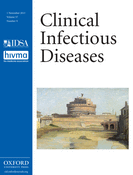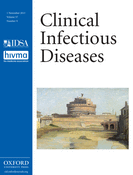
Cover image

On the cover: Castel Sant'Angelo, Rome, oil on canvas, 19th century, by Jean Baptiste Corot (French, 1796–1875). Musée des Beaux-Arts, Lille. Bridgeman Art Library, NY. Reproduced with permission.
Although built as Hadrian's mausoleum, this monument's name is linked to a severe epidemic that swept the city in 590. After a passionate sermon urging repentance from sins, Pope Gregory led citizens in a penitential procession through Rome, petitioning heaven for relief from the disastrous pestilence. As the procession neared Hadrian's mausoleum, Pope Gregory had a vision of the Archangel Michael sheathing his sword, symbolizing that the plague was over.
The sixth-century chronicle by Gregory of Tours describes the pestilence, as related to him by his deacon, who was in Rome at the time, as “the plague of the groin” (lues inguinaria), which killed its victims rapidly, affecting all households. Whether the numerous cycles of pestilence recorded as plague were all accurately identified, with cholera and typhus probably accounting for some of the calamities, this 590 epidemic is usually identified as the plague.
As the angel's appearance heralded the end of the 590 Rome epidemic, the image of the Archangel was rapidly adopted as a talisman against the plague, with the Roman tomb and papal fortress identified in medieval Rome as Castel Sant'Angelo.
(Mary & Michael Grizzard, Cover Art Editors)
Volume 57, Issue 9, 1 November 2013
NEWS
1 November News
IN THE LITERATURE
In the Literature
EMANUEL WOLINSKY AWARD
Emanuel Wolinsky Award
ARTICLES AND COMMENTARIES
Impact of an Evidence-Based Bundle Intervention in the Quality-of-Care Management and Outcome of Staphylococcus aureus Bacteremia
A clinical intervention on Staphylococcus aureus bacteremia (SAB) based on 6 selected evidence-based quality-of-care indicators was conducted in 12 tertiary hospitals in Spain. The intervention, carried out by microbiologists and infectologists, improved the management and mortality of patients with SAB.
Editorial Commentary: A Quality-of-Care Bundle for Treatment of Staphylococcus aureus Bacteremia: Ready for Prime Time?
Impact of Rapid Organism Identification via Matrix-Assisted Laser Desorption/Ionization Time-of-Flight Combined With Antimicrobial Stewardship Team Intervention in Adult Patients With Bacteremia and Candidemia
Integrating rapid organism identification with matrix-assisted laser desorption/ionization time-of-flight and real-time review and intervention by an antimicrobial stewardship team was associated with decreased mortality, decreased length of intensive care unit stay, improved time to effective and optimal antibiotic therapy, and decreased recurrent bacteremia.
The Importance of Long-term Acute Care Hospitals in the Regional Epidemiology of Klebsiella pneumoniae Carbapenemase–Producing Enterobacteriaceae
During region-wide point prevalence surveillance, we detected 9-fold higher rates of colonization with Klebsiella pneumoniae carbapenemase–producing Enterobacteriaceae among patients in long-term acute care hospitals, compared with intensive care unit patients in short-stay acute care hospitals.
Editorial Commentary: Long-term Acute Care Hospitals and Carbapenem-Resistant Enterobacteriaceae: A Reservoir for Transmission
Escherichia coli Sequence Type 131 (ST131) Subclone H30 as an Emergent Multidrug-Resistant Pathogen Among US Veterans
Among US veterans in 2011, Escherichia coli ST131, primarily its H30 subclone, accounted for most antimicrobial-resistant E. coli clinical isolates and was the dominant E. coli strain overall. Possible contributors included multidrug resistance, extensive virulence gene content, and ongoing transmission.
Editorial Commentary: Flying Under the Radar: The Stealth Pandemic of Escherichia coli Sequence Type 131
Severity Scoring Index for Crimean-Congo Hemorrhagic Fever and the Impact of Ribavirin and Corticosteroids on Fatality
Patients with Crimean-Congo hemorrhagic fever were stratified using a novel severity scoring index. Ribavirin was effective in reducing the casefatality rate among moderately ill patients, whereas steroids were beneficial particularly among patient with more-severe disease.
Impact of Routine Systematic Polymerase Chain Reaction Testing on Case Finding for Legionnaires’ Disease: A Pre–Post Comparison Study
The application of routine polymerase chain reaction testing on respiratory specimens from patients with pneumonia led to a >4-fold increase in case detection for Legionnaires' disease, and clarified the regional epidemiology of this disease.
Reporting Surgical Site Infections Following Total Hip and Knee Arthroplasty: Impact of Limiting Surveillance to the Operative Hospital
Using a statewide repository of hospital data that allowed patient tracking between facilities, we found that limiting surgical site infection (SSI) surveillance to the hospital where the operation took place caused varying degrees of SSI underestimation and impacted hospitals' relative rankings.
Editorial Commentary: Accountability for Surgical Site Infections: Will the Playing Field Be Level?
Case-Fatality Ratio and Effectiveness of Ribavirin Therapy Among Hospitalized Patients in China Who Had Severe Fever With Thrombocytopenia Syndrome
This study identifies clinical indicators that were associated with STFS fatal outcome. However, it finds no evidence to support effectiveness for use of ribavirin in the treatment of individuals with SFTS.
BRIEF REPORTS
Higher Incidence of Acute Kidney Injury With Intravenous Colistimethate Sodium Compared With Polymyxin B in Critically Ill Patients at a Tertiary Care Medical Center
Effect of Nucleic Acid Amplification Testing on Population-Based Incidence Rates of Clostridium difficile Infection
PHOTO QUIZ
A Mauritanian Woman With a Swollen Knee
INVITED ARTICLES
HIV/AIDS
Optimizing Care for HIV-Infected People Who Use Drugs: Evidence-Based Approaches to Overcoming Healthcare Disparities
People who use drugs experience delayed HIV diagnosis, reduced entry into and retention in care, delayed initiation of antiretroviral therapy, and inferior HIV outcomes. Overcoming healthcare disparities requires evidence-based, comprehensive packages of clinical/social services, including treatment for substance use disorders.
IMMUNOCOMPROMISED HOSTS
Infections in Children and Adolescents With Juvenile Idiopathic Arthritis and Inflammatory Bowel Disease Treated With Tumor Necrosis Factor–α Inhibitors: Systematic Review of the Literature
Tumor necrosis factor alpha (TNF-α) inhibitors can increase the risk of infections. This systematic literature review describes the epidemiology, microbiology, and types of infections reported in children and adolescents with juvenile idiopathic arthritis and inflammatory bowel disease treated with TNF-α inhibitors.
HIV/AIDS
A Randomized Controlled Pilot Trial of Valacyclovir for Attenuating Inflammation and Immune Activation in HIV/Herpes Simplex Virus 2–Coinfected Adults on Suppressive Antiretroviral Therapy
Herpes simplex virus type 2 (HSV-2) coinfection in HIV-infected individuals may contribute to increased systemic inflammation and immune activation that persist despite suppressive antiretroviral therapy. Valacyclovir did not decrease systemic immune activation in HIV-1/HSV-2–coinfected adults on suppressive antiretroviral therapy.
Missed Opportunities for Hepatocellular Carcinoma Screening in an HIV/Hepatitis C Virus–Coinfected Cohort
High Retention in Care Among HIV-Infected Patients Entering Care With CD4 Levels >350 cells/μL Under Routine Program Conditions in Uganda
Accounting for outcomes among those lost to follow-up in a Ugandan HIV treatment program among patients entering care with a CD4 count >350 cells/µL and not immediately eligible for antiretroviral therapy reveals retention to be higher than most prevailing estimates.
Burden of HIV-Related Cytomegalovirus Retinitis in Resource-Limited Settings: A Systematic Review
This systematic review found that prevalence of cytomegalovirus retinitis in resource-limited settings, notably Asian countries, remains high, indicating that HIV programs need to ensure capacity to manage the needs of patients who present late for care.



